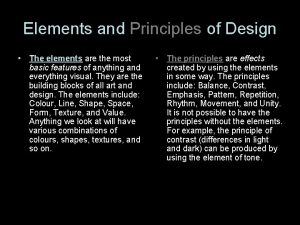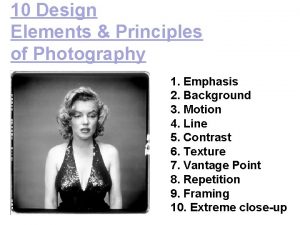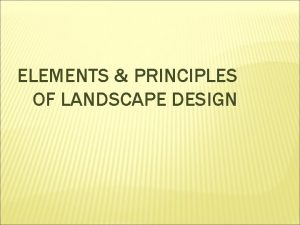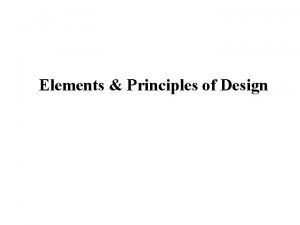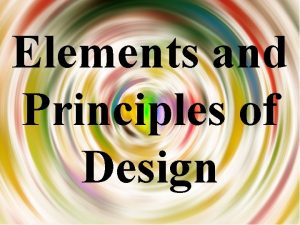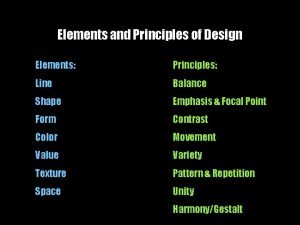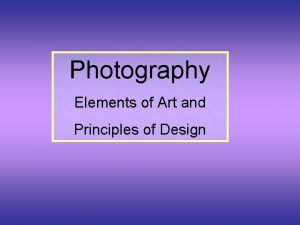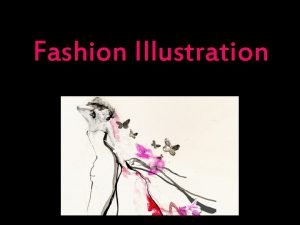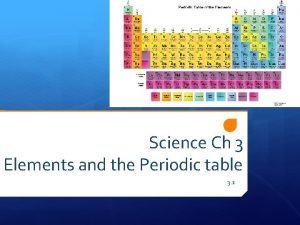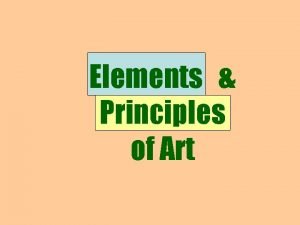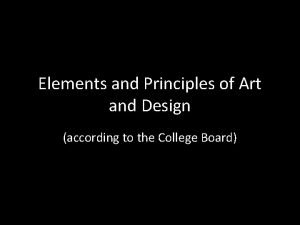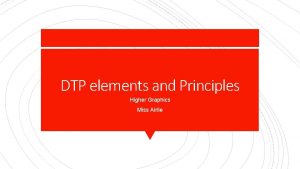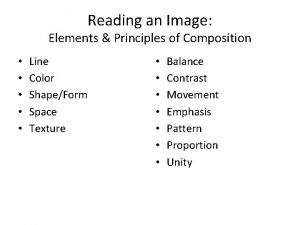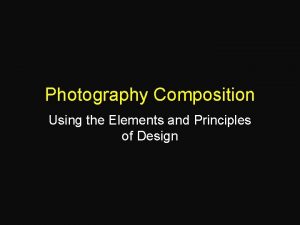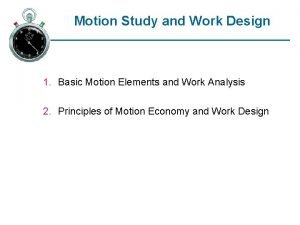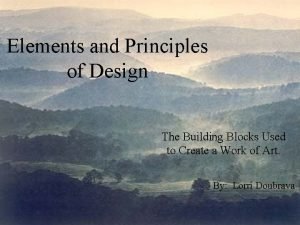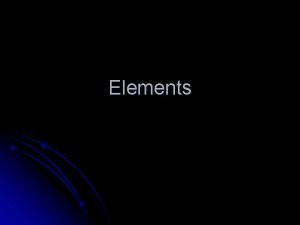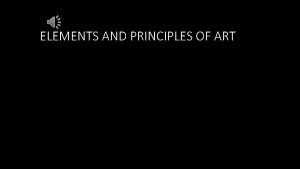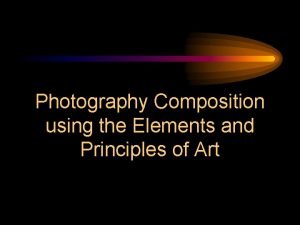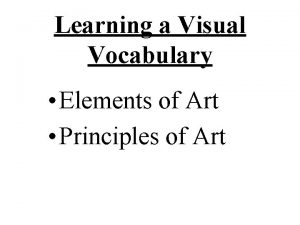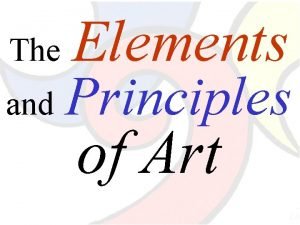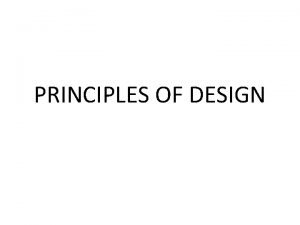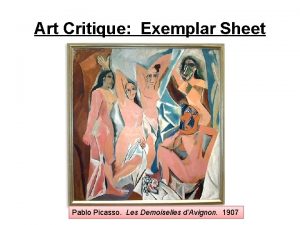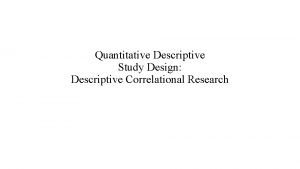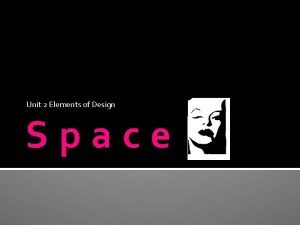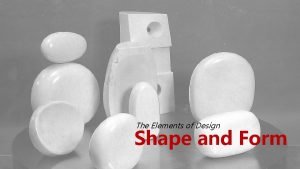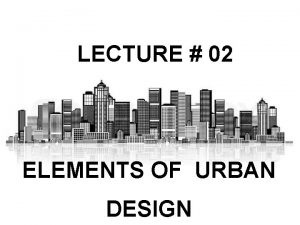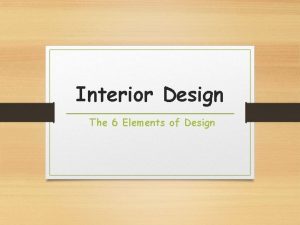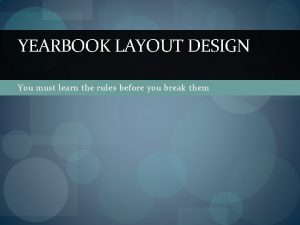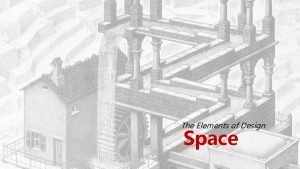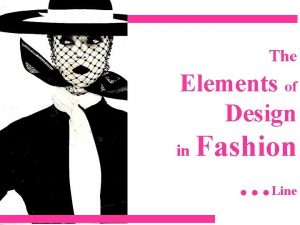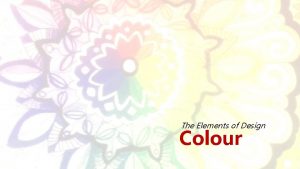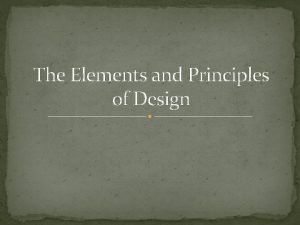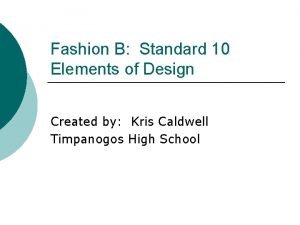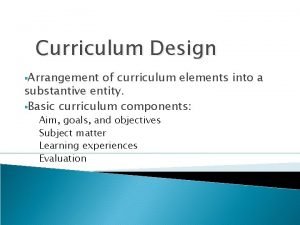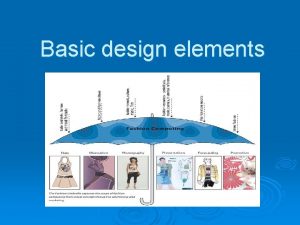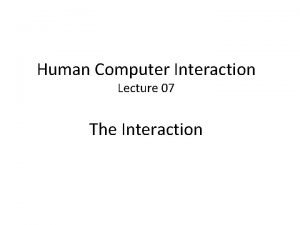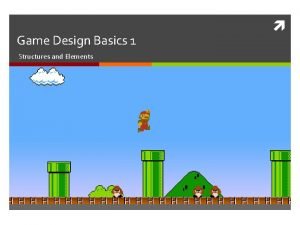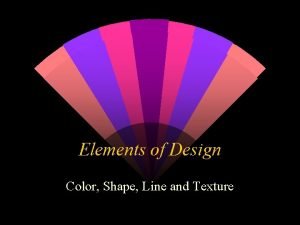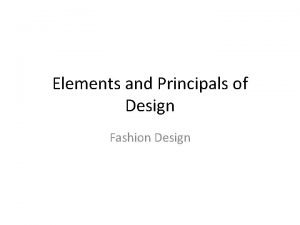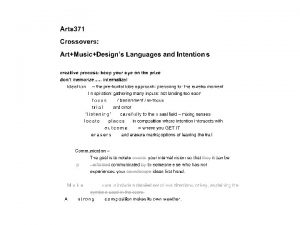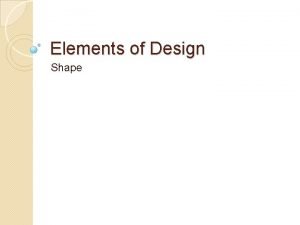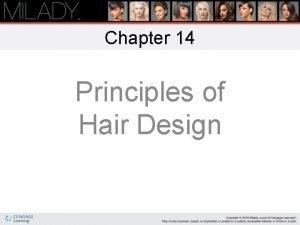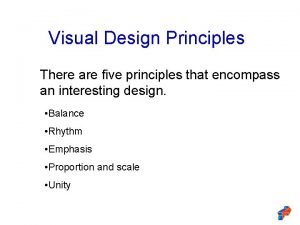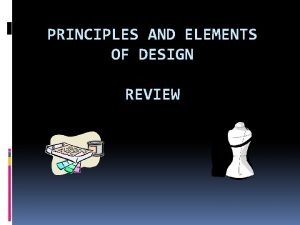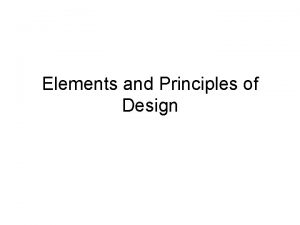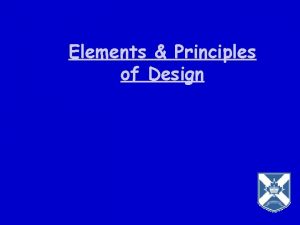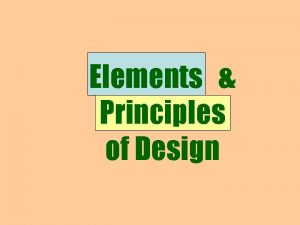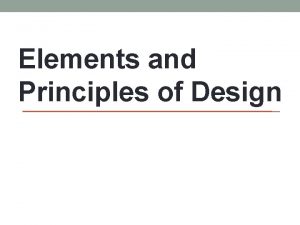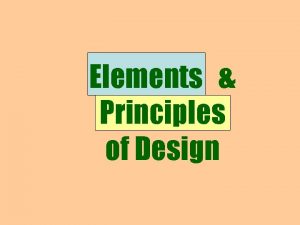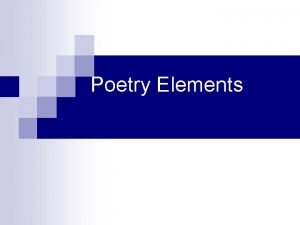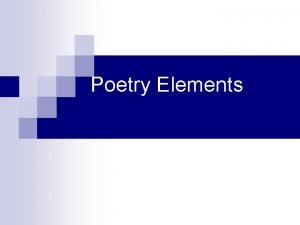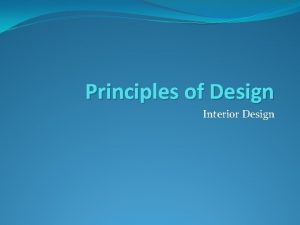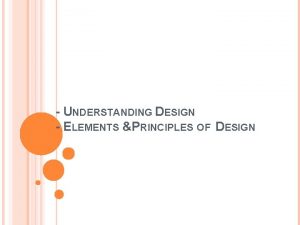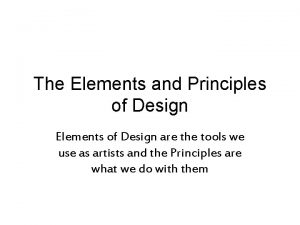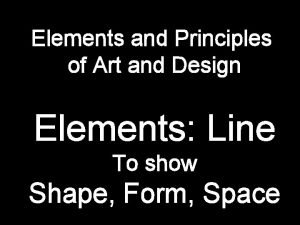Principles of Design The principles use the elements

























































































































- Slides: 121

Principles of Design The principles use the elements of design to create a composition.

Elements of Design The building blocks of design.

Balance is the act of comparing or estimating two things, one against the other, and the contrast between:

Balance �Balance is a feeling of visual equality in shape, form, value, color, etc. Balance can be symmetrical or evenly balanced or asymmetrical and un-evenly balanced. Objects, values, colors, textures, shapes, forms, etc. , can be used in creating a balance in a composition.

◦ Empty space (white space) and filled space ◦ Text and images ◦ Color and no colors and different colors ◦ Textures against flat colors Balance


�There are three different types of balance when using color, shape, and position: ◦ Symmetry ◦ Asymmetry ◦ Radial symmetry Balance in composition

Examples of radial balance

�What is it and how is it achieved on a flat surface? To answer this question, we must first think of a three dimensional work of art. �If the pieces were not physically balanced or anchored, they would fall over. Balance

�For images created on a flat surface such as a canvas the same principle of balance applies. �However, instead of having actual or physical balance, the artist needs to create an illusion of balance, referred to as visual balance. Balance

�In visual balance, each area of the painting suggests a certain visual weight, a certain degree of lightness or heaviness. �For example, light colors appear lighter in weight than dark colors. �Brilliant colors visually weigh more than neutral colors in the same areas. Balance

�Warm colors, such as yellow tend to expand an area in size, whereas cool colors like blue tend to contract an area. �And transparent areas seem to visually weigh less than opaque areas. Balance

Balance �Balancing the components of a painting can best be illustrated by weighing scales or a child's playground see-saw. �Visually the scale can be pictured as an apparatus for weighing or a see-saw which has a beam poised on a central pivot or fulcrum.

�In using this scale or see-saw, balance is not achieved through an actual physical weighing process, but through visual judgment on the part of the observer. �In this respect, visual balance refers to a "felt" optical equilibrium between all parts of the painting. Balance

To balance a composition is to distribute its parts in such a way that the viewer is satisfied that the piece is not about to pull itself over. When components are balanced left and right of a central axis they are balanced horizontally. When they are balanced above and below they are said to be balanced vertically. And when components are distributed around the center point, or spring out from a central line, this is referred to as radial balance.


There are two forms of visual balance. These are symmetrical balance, also known as symmetry or formal balance, and asymmetrical balance, also known as asymmetry or informal balance.

Symmetrical balance �Symmetrical balance is when the weight is equally distributed on both sides of the central axis. �Symmetry is the simplest and most obvious type of balance. It creates a secure, safe feeling and a sense of solidity. �Symmetrical balance can be achieved in two ways. �One way is by "pure symmetry, " and the other way is by "approximate symmetry. "

Symmetrical balance �In pure symmetry identical parts are equally distributed on either side of the central axis in mirror-like repetition. �A good example of pure symmetry is the human face. It is the same on both the right side and the left side of the nose. �Pure symmetry has its place in certain art works, however, because of its identical repetition, pure symmetry for a composition can easily become too monotonous and uninteresting to look at.

Symmetrical balance �Approximate symmetry on the other hand has greater appeal and interest for the viewer. �The two sides of a composition are varied and are more interesting to view. �Even though they are varied somewhat, they are still similar enough to make their repetitious relationship symmetrically balanced.

Symmetrical or formal balance �You can usually identify at least one of three lines of symmetry. ◦ Horizontal ◦ Vertical ◦ Diagonal

Symmetrical balance

Examples of symmetrical balance

Examples of asymmetrical balance

�The use of asymmetry in design allows for more freedom of creativity, because there are unlimited arrangements that may be devised using asymmetrical balance. Asymmetrical Balance

�The way to use asymmetry is by balancing two or more unequal components on either side of the fulcrum by varying their size, value or distance from the center. Asymmetrical Balance

�Asymmetrical balance is when both sides of the central axis are not identical, yet appear to leave the same visual weight. �It is a "felt" equilibrium or balance between the parts of a composition rather than actual. Asymmetrical Balance

�If the artist can feel, judge or estimate the various elements and visual weight, this should allow him/her to balance them as a whole. �As a result, a more interesting composition will occur in the work.

This flower resting a tea cup on the left is a good example of radial balance. The pedals radiate out from a central point. On this side radial balance is created by the flowers which spring out of the center of the vase. Examples of The Effective Use Of Balance

Horizontal Balance

Vertical Balance Do you see the vertical balance suggested in the painting on the left? Look at where the foreground ends and you will quickly see how it is balanced by the building in the background This painting on the right is a little more obvious in it's vertical balance. Notice how the three objects in the top part of the painting balance the apparent heaviness of the one object (the plate of pancakes) in the lower part of the painting.

Contrast is the juxtaposition of opposing elements

“The difference in brightness between the light and dark areas of a picture, such as a photograph or video image ” “The use of opposing elements, such as colors, forms, or lines, in proximity to produce an intensified Contrast effect in a work of art “

Example of Nature Contrast


Contrast �Contrast in art and design occurs when two related elements are different. �The greater the difference the greater the contrast. Contrast adds variety to the total design and creates unity. �It is what draws the viewer's eye into the painting and helps to guide the viewer around the art piece.

� Contrast in art also adds visual interest. Most designs require a certain amount of contrast. Too much similarity of the components in any design becomes monotonous. � In other words the use of too little contrast can cause a design to be bland uninteresting. � On the other hand too much contract can be confusing. Just the right amount of contrast engages the viewer's participation in comparing various components of the work. Contrast

�For instance, the viewer will compare light and dark areas of a painting, wide lines and thin lines, light-weight forms and heavy forms, filled spaces and unfilled spaces, etc. �The key to working with contrast is to make sure the differences are obvious. The most common ways of creating contrast are by creating differences in: Contrast

�The key to working with contrast is to make sure the differences are obvious. The most common ways of creating contrast are by creating differences in: • size • value • color • type • texture • shape • alignment • direction • movement Contrast

In the painting on the left is another example of contrast between light and darkness. Contrast in the painting on the right is much more subtle. Contrast this painting is in texture. Notice the hard texture on the fence as contrasted with the softness of the butterflies and the kittens. Also a contrast exists between the soil and the foliage.

Contrast The contrast in the illustration to the left is quite obvious. Notice the contrast of the light background (wall) with dark foreground (table cloth) and the contrast of the dark shadows on the tea pot and cup against the wall and with the lights of the same objects against a dark window. There is also a contrast of thin and thick lines in the napkin, straight and curved lines, and don't miss the dark steam as contrasted with the light clouds off in the distance On the right a contrast exists between the lights and darks. Also notice the contrast of the roundness of the objects in the foreground against the flatness of the background.

Emphasis is used to make certain parts of their artwork stand out and grab your attention. The center of interest or focal point is the place a work draws your eye to first.


Emphasis: To express with particular stress or force. What message is stressed here?

Emphasis � Emphasis is the stressing of a particular area of focus rather than the presentation of a maze of details of equal importance. When a composition has no emphasis nothing stands out. However the effective use of emphasis calls attention to important areas of the painting. By placing emphasis on certain areas of the composition, an artist creates elements of interest which causes the eye to return to again and again. �

Emphasis � One way of achieving emphasis is by creating center of interest, a. k. a. a focal point. � A focal point is an area where the eye tends to center. It is the focus of the viewer's attention. � A focal point is created by making one area of element of the painting dominant, or most important visually with all other areas contributing but subordinate. � is canceled out.

�The focal point may be the largest, brightest, darkest, or most complex part of the whole, or it may get special attention because it stands out for some other reason. �No more than one component should vie for primary attention. Where several components get equal billing, emphasis Emphasis

�The second way to create emphasis is by contrasting the primary element with its subordinates, or emphasis can be created by a sudden change in direction, size, shape, texture, color, tone or line. Emphasis

�No matter what element is chosen for emphasis it should never demand all the attention. �Emphasis is necessary, but a good composition is one in which all the elements work together for a unifying effect. Emphasis


In this painting it is easy to see how the artist used light to emphasize the chef. He stands out as the main focal point of the entire the painting. The artist created emphasis in this painting through the use of color. By painting the cowboy's shirt red he was able to create a center of interest.

Proportion describes the size, location or amount of one thing compared to another.


�Proportion in art is the comparative harmonious relationship between two or more elements in a composition with respect to size, color, quantity, degree, setting, etc. ; i. e. ratio. �A relationship is created when two or more elements are put together in a painting. Proportion

�This relationship is said to be harmonious when a correct or desirable relationship exists between the elements. �This refers to the correct sizing and distribution of an element or object which creates good proportion. �Good proportion adds harmony and symmetry or balance among the parts of a design as a whole. Proportion

�When the principle of proportion is applied to a work of art it is usually in the relationship of size. �That is, the size of one element of the composition as compared to the size of another related element. Proportion

Proportion �In the instance of a relationship of size a comparison is made between the: ◦ height, width and depth of one element to that of another ◦ size of one area to the size of another area ◦ size of one element to the size of another element ◦ amount of space between two or more elements

Proportion �Proportion is usually not even noticed until something is out of proportion. When the relative size of two elements being compared seems wrong or out of balance it is said to be "out of proportion". �For example if a person has a head larger than their entire body, then we would say that they were out of proportion.


� There are several ways for achieving good proportion: � Place together elements which are similar in character or have some feature in common. � Create major and minor areas in the design, as equal parts can quickly become monotonous and boring. However, the differences in size must not be so great as to make the parts appear unrelated and therefore, out of harmony with each other. Good Proportion

� Arrangement of space should be in such a way that the eye does not perceive a standard mathematical relationship. Dividing up the composition in halves, quarters and thirds should be avoided. A subtle relationship creates a more dynamic design. � Create harmony in the art work. Harmony is an agreement between the shapes that stresses the similarities of all parts. In other words, the shape of one part should "fit" the shape of the adjoining elements. Shapes should "fit" properly in their positions and spaces. Good Proportion

In the two paintings above proportion emphasizes the distance of the ship and the vastness of the ball room. There is a real sense of proportion in each of the two paintings above. Without the effective use of the principle of proportion you would not experience the majesty of the mountain cliffs in the painting on the left or the towering height of the trees in the painting on the right.

Pattern is created by repeating an element (line, shape or color) over and over again.


Gradation of size and direction produce linear perspective. Gradation of color from warm to cool and tone from dark to light produce aerial perspective. Gradation can add interest and movement to a shape. A gradation from dark to light will cause the eye to move along a shape.


Graphic design principles are ways in which elements are used together. Movement Balance Emphasis Unity

MOVEMENT Movement is the use of lines, color, and repetition to create the illusion of motion.

�Curved forms or lines �Repetition of geometric forms �Fuzzy lines or outlines Movement

Alignment “Nothing should be placed on the page arbitrarily. Every item should have a visual connection with something else on the page. ”

Alignment No element has any connection to the others. § Elements aligned

Alignment Here’s a pretty standard layout, centered.

Alignment But look how much crisper it looks with alignment, plus some thought about proximity.

Alignment Trapped white space pushes elements apart Does the text go with the cartoon, or are they independent chunks of information? The ragged right type seems to separate the elements.

Alignment “Find a strong line and use it. ” Flush right type makes use of image’s border. Change the alignment, and it becomes obvious that they go together. Note the strong lines Robin Williams uses in this example to get alignment. Flush right type, strong vertical line on the cartoon.

Alignment “Find a strong line and use it. ” Flush right type makes use of image’s border. Change the alignment, and it becomes obvious that they go together. Note the strong lines Robin Williams uses in this example to get alignment. Flush right type, strong vertical line on the cartoon.

Repetition Repeat some aspect of the design throughout the entire piece. ”

Repetition When you get to the end of the information, does your eye just wander off the card? Here we go with the band again. Not a bad card, right? But note the question here: Now look at the change. . .

Repetition Repeated bold type encourages reader to “bounce” between the two dominant typefaces Boldfacing that number, so it pairs with the headline, really makes it jump, and it hold your eye on the information.

Proximity “Proximity, or closeness, implies a relationship. ”

Key idea: “Group related items together” Proximity

Proximity Solution: Contents are grouped Contrast is added with headlines/rules

Problem: Reader’s eye must bounce all around card to obtain information Proximity

Proximity Solution: Group together related elements

Proximity Problems: The two items in top left are in close proximity but not related Gaps separate related items

Proximity Solution: Regroup information Change to caps/lowercase Use squared edges Let image break out of box

Proximity Problem: Everything is close to everything else

Scale Dimensional element's defined by other elements of design-size relative to other art, its surroundings, or in relation to human size.

� �Unusual or even unexpected scale can certainly be used as a attention grabber. �Another consideration for size and scale is to look at the elements within the creation itself. �. Scale

Scale �Scale can attract in different ways. It can be use to draw attention to the unexpected or exaggerated - this is often the case in advertising. �Changing the natural scale is certainly not unusual. It is frequently used in religious painting

Scale �A scale model is a physical model, a representation or copy of an object that is larger or smaller than the actual size of the object, which seeks to maintain the relative proportions (the scale factor) of the physical size of the original object.

Scale

Scale

Scale

Scale Very often the scale model is smaller than the original and used as a guide to making the object in full size. Scale models are built or collected for many reasons.

Variety A way of accomplishing this is to establish an approach which involves theme and variations-repeating the same image, but in different sizes, colors, values and shapes.

Variety By varying the components of a visual design, the artist creates interest and avoids monotony.

Harmony

Examples of the effective use of Harmony It is easy to observe harmony in action in nature. Notice how the individual wedges "fit" the orange in the painting above. In the coat of arms above we observe how the different elements "fit" together perfectly inside each other to create harmony.

Realistic, Stylized, Abstract The less a work of art resembles something in the physical world, the more stylized it is.

One of the fundamental properties of visual art is the degree to which it is realistic or stylized (abstract). Realistic, Stylized, Abstract

realism ◄—————————-------► stylization A very realistic statue. A significantly stylized statue; note the rigid facial expression, stiff posture, and patterned hair texture. An extremely stylized sculpture One of the fundamental properties of visual art is the degree to which it is realistic or stylized (abstract). The less a work of art resembles something in the physical world, the more stylized it is.

realism ◄—————————-------► stylization A very realistic painting A significantly stylized painting; note the simplified/distorted shapes and colors. A completely stylized painting Art that resembles nothing in the physical world is called abstract, while art that portrays something recognizable (however distorted) is called representational.

One can also distinguish narrative art (which tells a story) and decorative art (which doesn't). A decorative work can be abstract or representational. A story (in the usual sense), however, can only be told through representational art. Abstract art is inherently decorative This representational art is decorative: the octopus is not doing anything, it is simply "there". This representational art is narrative: the figures are involved in an action/story.

Rule of Thirds The Rule of Thirds is based on the fact that the human eye is naturally drawn to a point about two-thirds up a page. Crop your photo so that the main subjects are located around one of the intersection points rather than in the center of the image:

More on Rules �rules of composition �the rule of thirds �golden section/rectangle. �harmony �balance �discord �drama.


� Your landscapes will be optimally pleasing to the eye if you apply the Rule of Thirds when you place your horizon line. � If the area of interest is land or water, the horizon line will usually be two-thirds up from the bottom. � Alternately, if the sky is the area of emphasis, the horizon line may be one-third up from the bottom, leaving the sky to take up the top twothirds of the picture: Rule of Thirds


�It has been found that certain points in a picture's composition automatically attract the viewer's attention. �Similarly, many natural or man-made objects and scenes with certain proportions (whether by chance or by design) automatically please us. Rule of Thirds

�Leonardo da Vinci investigated the principle that underlies our notions of beauty and harmony and called it the Golden Section. �Long before Leonardo, however, Babylonian, Egyptian, and ancient Greek masters also applied the Golden Section proportion in architecture and art. Golden Section rule

� To get a clearer sense of these special "Golden" composition points, imagine a picture divided into nine unequal parts with four lines. � Each line is drawn so that the width of the resulting small part of the image relates to that of the big part exactly as the width of the whole image relates to the width of the big part. � Points where the lines intersect are the "golden" points of the picture: Golden Section rule


� One side of the picture is divided into two, and then each half is divided into three parts. � The adjacent side is divided so that the lines connecting the resulting points form a diagonal frame. � According to the Diagonal Rule, important elements of the picture should be placed along these diagonals: Diagonal rule


Linear elements, such as roads, waterways, and fences placed diagonally, are generally perceived as more dynamic than horizontally placed ones:

Composition The combining of distinct elements to form a whole

Don’t Be a Wimp (in your designs) v. Use Color v. Place information in frames and boxes (remove the lines) v. Hierarchy, Hierarchy v. Use Clip Art v. Make it to add to your materials FUN for you and your reader!


Solution: § Contrast §Repetition §Alignment § Proximity Contrast, Repetition, Alignment, and Proximity Here is an ad with all four principles being applied. How are they being used here?

Summary �The basis of good graphic design is use of design elements and their thoughtful application in the form of design principles. �Clearly identify what you are trying to accomplish — use design to convey your message. �Brainstorm alternatives.
 5 elements of hair
5 elements of hair Light and warm colors create the illusion of
Light and warm colors create the illusion of Opposition floral design
Opposition floral design Elements and principles of design chart
Elements and principles of design chart Principles of interior design ppt
Principles of interior design ppt Visual design principles and elements matrix
Visual design principles and elements matrix Art basics
Art basics Elements and principles of design fashion
Elements and principles of design fashion Elements and principles of design space
Elements and principles of design space Photography elements of design
Photography elements of design Elements of design in architecture
Elements of design in architecture Elements and principles of landscape design
Elements and principles of landscape design What are the elements and principles of design
What are the elements and principles of design Christina's world
Christina's world Visual elements and principles of design
Visual elements and principles of design Photography elements and principles
Photography elements and principles Elements and principles of design fashion
Elements and principles of design fashion Hình ảnh bộ gõ cơ thể búng tay
Hình ảnh bộ gõ cơ thể búng tay Ng-html
Ng-html Bổ thể
Bổ thể Tỉ lệ cơ thể trẻ em
Tỉ lệ cơ thể trẻ em Chó sói
Chó sói Glasgow thang điểm
Glasgow thang điểm Chúa sống lại
Chúa sống lại Các môn thể thao bắt đầu bằng tiếng đua
Các môn thể thao bắt đầu bằng tiếng đua Thế nào là hệ số cao nhất
Thế nào là hệ số cao nhất Các châu lục và đại dương trên thế giới
Các châu lục và đại dương trên thế giới Công thức tính độ biến thiên đông lượng
Công thức tính độ biến thiên đông lượng Trời xanh đây là của chúng ta thể thơ
Trời xanh đây là của chúng ta thể thơ Mật thư tọa độ 5x5
Mật thư tọa độ 5x5 101012 bằng
101012 bằng Phản ứng thế ankan
Phản ứng thế ankan Các châu lục và đại dương trên thế giới
Các châu lục và đại dương trên thế giới Thể thơ truyền thống
Thể thơ truyền thống Quá trình desamine hóa có thể tạo ra
Quá trình desamine hóa có thể tạo ra Một số thể thơ truyền thống
Một số thể thơ truyền thống Bàn tay mà dây bẩn
Bàn tay mà dây bẩn Vẽ hình chiếu vuông góc của vật thể sau
Vẽ hình chiếu vuông góc của vật thể sau Biện pháp chống mỏi cơ
Biện pháp chống mỏi cơ đặc điểm cơ thể của người tối cổ
đặc điểm cơ thể của người tối cổ V. c c
V. c c Vẽ hình chiếu đứng bằng cạnh của vật thể
Vẽ hình chiếu đứng bằng cạnh của vật thể Vẽ hình chiếu vuông góc của vật thể sau
Vẽ hình chiếu vuông góc của vật thể sau Thẻ vin
Thẻ vin đại từ thay thế
đại từ thay thế điện thế nghỉ
điện thế nghỉ Tư thế ngồi viết
Tư thế ngồi viết Diễn thế sinh thái là
Diễn thế sinh thái là Dot
Dot Số nguyên tố là gì
Số nguyên tố là gì Tư thế ngồi viết
Tư thế ngồi viết Lời thề hippocrates
Lời thề hippocrates Thiếu nhi thế giới liên hoan
Thiếu nhi thế giới liên hoan ưu thế lai là gì
ưu thế lai là gì Khi nào hổ mẹ dạy hổ con săn mồi
Khi nào hổ mẹ dạy hổ con săn mồi Sự nuôi và dạy con của hổ
Sự nuôi và dạy con của hổ Sơ đồ cơ thể người
Sơ đồ cơ thể người Từ ngữ thể hiện lòng nhân hậu
Từ ngữ thể hiện lòng nhân hậu Thế nào là mạng điện lắp đặt kiểu nổi
Thế nào là mạng điện lắp đặt kiểu nổi Yesterday
Yesterday Elements of drama and theatre
Elements of drama and theatre Elements and sub elements
Elements and sub elements Atomic elements vs molecular elements
Atomic elements vs molecular elements Http //elements.wlonk.com/elements table.htm
Http //elements.wlonk.com/elements table.htm Theme of a folktale
Theme of a folktale Element of folklore
Element of folklore 9 rational use of drugs
9 rational use of drugs Types of emphasis in art
Types of emphasis in art Elements principles of art
Elements principles of art A feeling of visual equality
A feeling of visual equality Dtp elements and principles
Dtp elements and principles Elements and principles of composition
Elements and principles of composition The area used or unused in a composition
The area used or unused in a composition 17 therbligs
17 therbligs Post modern principles
Post modern principles Elements and principles of art
Elements and principles of art Robert longo
Robert longo Elements and principles of art
Elements and principles of art Elements and principles of art
Elements and principles of art Theatre
Theatre Elements principles of art
Elements principles of art Random rhythm in architecture
Random rhythm in architecture Photography principles
Photography principles Visual vocabulary art
Visual vocabulary art Elements and principles of art
Elements and principles of art Banjo lesson painting
Banjo lesson painting Les demoiselles d'avignon elements and principles
Les demoiselles d'avignon elements and principles Correlational descriptive design
Correlational descriptive design Next use information in compiler design
Next use information in compiler design Elements of design space
Elements of design space Form and shape
Form and shape Urban form elements
Urban form elements Design objectives
Design objectives Key elements of an advertisement
Key elements of an advertisement Elements of visual design
Elements of visual design Coast salish territory
Coast salish territory Non contrived study setting
Non contrived study setting Dominant rules
Dominant rules Elements of design: space
Elements of design: space Elements of design fashion
Elements of design fashion Elements of design colour
Elements of design colour Introduction to elements of design
Introduction to elements of design Machine elements in mechanical design 5th edition
Machine elements in mechanical design 5th edition Six elements of research design
Six elements of research design Elements of design in fashion
Elements of design in fashion Tick the elements you find in the ad
Tick the elements you find in the ad Arrangement of curriculum is known as
Arrangement of curriculum is known as Design elements colour
Design elements colour Minimal moderate and excessive interference
Minimal moderate and excessive interference Elements of wimp interface in hci
Elements of wimp interface in hci Game design structure
Game design structure Line color shape texture
Line color shape texture Elements of design fashion
Elements of design fashion Design is a plan for arranging elements
Design is a plan for arranging elements Machine elements in mechanical design
Machine elements in mechanical design Plane design element
Plane design element Curriculum meaning
Curriculum meaning Assessment meaning
Assessment meaning Elements of design shape
Elements of design shape Elements of quality by design
Elements of quality by design What are the five elements of hair design
What are the five elements of hair design Graduated rhythm in design
Graduated rhythm in design








